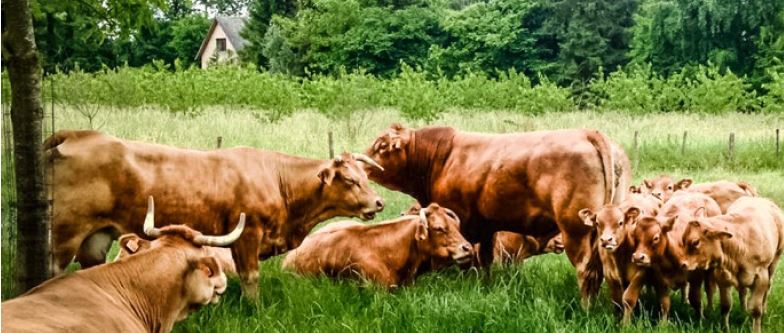INNOVATION EXPLAINED
Silva is Latin for ‘forest’ and pasture stands for the area where livestock graze. Hence, silvopastures are a type of agroforestry system where crops, trees and livestock are being combined. This system can be applied with all types of crops and livestock systems. It is an ancient system, in Spain it is been done for ages and known as dehesa, and in Japan in the Kyushu province it is a common practice. It can provide an economic return while creating a sustainable system, having many benefits for the environment.
 Silvopastural system with cattle, source: Rundveeloket
Silvopastural system with cattle, source: Rundveeloket
Different silvopastorial systems exist; silvopastures are the combination of permanent grassland, livestock and trees, while in a agrosilvopastorial system livestock and trees are combined with silage. Another type is silviculture, where trees are combined with only crops.
Within a silvopastorial system, animals are grazed between trees. Grass can grow longer and the trees provide fruits or wood, or are eaten by the animals. These trees provide shelter and shadow, which is also beneficial for the grass underneath. Rotational grazing gives forage trees or shrubs a chance to recover sufficiently, stimulates the formation of new shoots and increases productivity. Another benefit of rotational is grazing is to adapt the grazing scheme to the growing season of the trees. Different plants may have different unwanted insects. For example, when the first fruit is falling down the tree, this is possibly unhealthy and infected with insects. When these fruits are eaten, it prevents second infection. Before the harvest, animals should be moved to another part, so the healthy fruits can be harvested and sold. In this way, animal can also help in pest control. However, timing is critical, both for pasture and tree health.
The choice of the trees depend on many factors. Deep-rooting trees bring nutrients from deeper soil layers back into the system. Under certain conditions, they can also act as a water pump in dry soils, releasing water to the environment at night. In wet soils, superficially rooting trees can just help with drainage. In addition, nitrogen-fixing trees can take a lot of nitrogen from the air each year. This not only provides leaves with a high protein content, but also nitrogen for the crop around the trees.
Most of the nutrients of trees and shrubs are in the leaves. Leaves contain more proteins, fats and sugars than grass. They are a source of minerals, trace elements and secondary plant substances. These secondary phytochemicals can be toxic (e.g. taxin in yew), but can also have positive effects on the health of ruminants. In excessive amounts or with certain rations, the effects may become negative.
How to start?
Soil needs to be ploughed before trees are planted. Trees can be planted in rows, clusters or evenly spread, as long as sufficient light can hit the ground. Make sure, if animals are already grazing on the field that they cannot eat from the young trees. During the first few years, it is all about weed control. When trees reach a certain height, you can annual cut/bud shortly before the growing season, which will produce new shoots that are easy to "graze". To realise the potential added value of the silvopastorial system, intensive management is required. Sufficient knowledge and maintenance of each component is required to achieve good results. If this knowledge is lacking, it is best to bring it in externally.
The choice of trees depend on many factors, such as soil type, machinery, shade/wind shelter, feeding tree, fruits/nuts for human consumption, wood production, water holding capacity, etc.
- Shelter: it is important to choose species that grow fast enough. They also should have a dense and/or wide crown cover (shade) or dense vertical structure (windbreak). Numerous options: willow, black alder, hornbeam, sweet chestnut, oak, field maple, sycamore, false acacia, etc.
- Forage tree: tastiness is the determining factor. Other than that, feed value (energy, proteins, etc.), digestibility, toxicity, antibacterial effect, favorable effect on meat quality and growth rate are also factors to take in consideration. Some options: willow species, hazel, poplar, blackberry, fruit trees, hornbeam, alder, ash, oak, elm, etc.
- Wood production: some options: sweet cherry, grey and white poplar, summer and sessile oak, sweet chestnut, rowan, alder, etc.
IMPACT ON FARM PERFORMANCE
Socio-economic resilience
- Economic return from forage/livestock production
- It is possible to market your product in a different way and increase the price slightly
- No fertilizer or pesticides are used
- ‘Looks nice’ walking by such a field
Animal health and welfare
- Animals walk freely in pasture, enough shading, different feedstuffs available
- More extensive system
Production efficiency and meat quality
Environmental sustainability
- C-sequestration
- Trees like hazels can be added on the field. They are known to also reduce enteric methane emissions
FURTHER INFORMATION
Silvopastures are slow to implement. It takes a few years before the trees are grown.
Adapt the type of trees and livestock to your area and farm goals.
Silvopastorial systems are perfect on marginal land that is not great for crop production. Less ideal is areas like wetlands.
Key success factors
- Animals should be matched to the land type
- Trees should match the soil type and microclimate
- Forage and fodder should be diverse and support resilient food supply for animals
AUDIO-VISUAL MATERIAL
Mark changed to a silvopastorial system in the 90s (Upper Midwest). He is combining pigs and cattle with trees like chestnut, hazelnut and apple. By rotational grazing, the animals help in the pest control. As animals grow between fruit trees, he markets his meat as ‘hazel-grown’, which can be interesting for pricing the meat. Click here to watch video.